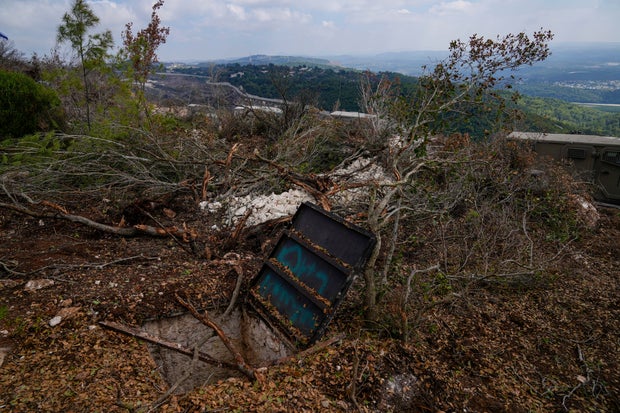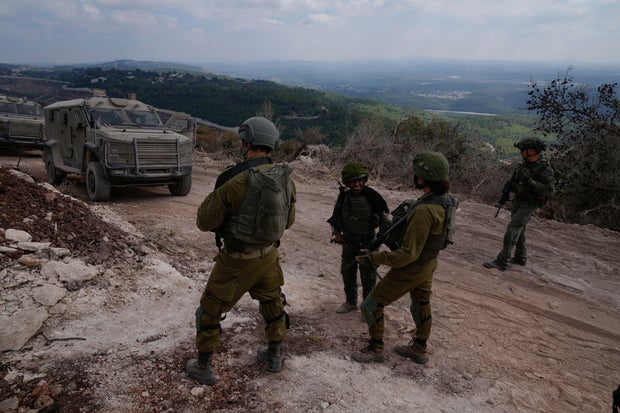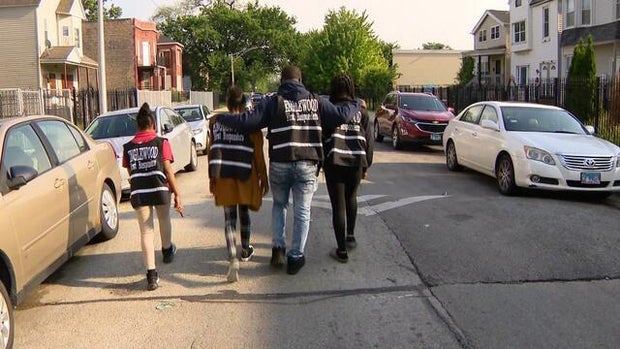CBS News
U.S. says Israel killing Hamas chief Yahya Sinwar brings chance for peace in Gaza, but the war continues

Prime Minister Benjamin Netanyahu said Thursday that the killing of Hamas leader Yahya Sinwar had “settled the score with him,” but stressed that “the task before us [Israel] is not yet complete.”
Netanyahu said Israel’s focus was on securing the return of the roughly 100 hostages still in Gaza, taken during Hamas’ brutal Oct. 7 attack last year, of whom a third are believed to be dead.
“This is an important moment in the war,” Netanyahu said to the families of the hostages, according to the Reuters news agency. “We will continue full force until the return home of all your loved ones, who are our loved ones, too. This is our supreme obligation. This is my supreme obligation.”
President Biden said Sinwar’s death after almost two decades of Hamas rule in Gaza was good news, “for Israel, for the United States, and for the world.” Along with other senior U.S. officials, he indicated that it should bring new hope for a cease-fire in the year-long war.
Speaking Friday in Germany, Mr. Biden said he’d told Netanyahu that Sinwar had blood on his hands, adding: “Let’s also make this moment an opportunity” for peace.
But Hamas did not mention any renewed push for a cease-fire agreement with Israel after the killing of its leader.
“It seems that Israel believes that killing our leaders means the end of our movement and the struggle of the Palestinian people,” Dr. Basem Naim, a member of the U.S. and Israeli-designated terrorist group’s Political Bureau said in a statement on Friday. “They can believe what they want, and this is not the first time they said that.”
“Hamas each time became stronger and more popular, and these leaders became an icon for future generations to continue the journey towards a free Palestine” Naim said.
The killing of Sinwar, Hamas’ top commander in Gaza since 2017 and the group’s overall leader since August, was a massive blow to Hamas. Senior Hamas spokesperson Ismael al-Sawarta told CBS News in Gaza on Thursday that his death would “complicate the situation, because he was the key for the negotiations and he was the political leader of Hamas.”
But he added: “I don’t think his death will impact or change the war, because the Palestinian resistance is not led by an individual, but it is an institution.”
Deputy Hamas leader Khalil al-Hayya confirmed Sinwar’s death Friday in a televised speech, and said the group would continue on the same path it’s been on. Al-Hayya said Hamas would not release the remaining hostages without a cease-fire deal and the withdrawal of Israeli troops from Gaza.
All three Hamas officials noted that the group had kept up its fight against Israel following the assassination in late July of its previous political chief Ismail Haniyeh in Iran. Israel has killed many senior figures of both Hamas and its powerful ally Hezbollah in Lebanon in recent months — but it continues fighting both groups in conflicts that have killed tens of thousands of people, most of them civilians.
Many Israelis were jubilant over Sinwar’s death, gathering Thursday on beaches and even outside the lab where his remains were identified to chant and dance.
MENAHEM KAHANA/AFP/Getty
But not everyone in the country was celebrating, and many did not appear to share in the hope that his killing might mean a turning point for the war, or for their missing loved ones.
At a rally outside the Defense Ministry for the hostages still held in Gaza, families and supporters told CBS News they feared Hamas militants could now kill those who’ve survived more than a year in captivity.
Asked whether she believed Israel was actually closer to peace, or possibly further away after Sinwar’s killing, a woman at the rally who only gave her first name, Ariella, was unsure.
“I don’t know. I wish I knew,” she told CBS News. “I want it to be closer to be peace. I really want them to be back. I want everything to be okay again.”
Among the hostages still in Gaza is 23-year-old Israeli-American Omer Neutra. His parents Orna and Ronen just marked their son’s birthday — without him, for the second time.
“It’s just unfathomable that this is his second birthday in captivity,” Orna said. “We really, really hope that this nightmare will finally come to an end for us… We are still stuck on October 7th; One long, nightmarish day.”
Israel launched its war in Gaza in immediate response to Hamas’ terrorist attack, which killed 1,200 people and saw 251 others taken hostage. That war has now killed more than 42,400 Palestinians, wounded almost 100,000, and displaced virtually the entire 2.3 million people of the Gaza Strip, according to the Hamas-run enclave’s health ministry.
And despite the remarks from Mr. Biden suggesting a new opportunity to push for peace, the Israeli military was still escalating its operations in northern Gaza on Friday.
Palestinians in Gaza, who’ve lived under constant bombardment for a year and been displaced time and time again, voiced little optimism to CBS News.
“It won’t change anything,” one woman said of Sinwar’s death. “Someone else will replace him. God willing, the war will end and we will go back home.”
CBS News
Israel unearths a web of tunnels used by Hezbollah in southern Lebanon

Israeli forces have spent much of the past year destroying Hamas’ vast underground network in Gaza. They are now focused on dismantling tunnels and other hideouts belonging to Hezbollah militants in southern Lebanon.
Scarred by Hamas’ deadly raid into Israel last year that sparked the war in Gaza, Israel says it aims to prevent a similar incursion across its northern border.
The Israeli military has combed through the dense brush of southern Lebanon for the past two weeks, uncovering what it says are Hezbollah’s deep attack capabilities — highlighted by a tunnel system equipped with weapons caches and rocket launchers that Israel says pose a direct threat to nearby communities.
Sam McNeil / AP
Israel’s war against the Iran-backed militant group stretches far inside Lebanon, and its airstrikes in recent weeks have killed more than 1,700 people, about a quarter of whom were women and children, according to local health authorities. But its ground campaign has centered on a narrow patch of land just along the border, where Hezbollah has had a longstanding presence.
Hezbollah has deep ties to southern Lebanon
Hezbollah, which has called for Israel’s destruction, is the Arab world’s most significant paramilitary force. It began firing rockets into Israel a day after Hamas’ Oct. 7, 2023, attack from Gaza. After nearly a year of tit-for-tat fighting with Hezbollah, Israel launched its ground invasion into southern Lebanon on Oct. 1 and has since sent thousands of troops into the rugged terrain.
Even as it continues to bolster its forces, Israel says its invasion consists of “limited, localized and targeted ground raids” that are meant to destroy Hezbollah infrastructure so that tens of thousands of displaced Israelis can return home. The fighting also has uprooted more than 1 million Lebanese in the past month.
Sam McNeil / AP
Many residents of southern Lebanon are supporters of the group and benefit from its social outreach. Though most fled the area months ago, they widely see the heavily armed Hezbollah as their defender, especially as the U.S.-backed Lebanese army does not have suitable weapons to protect them from any Israeli incursion.
That broad support has allowed Hezbollah to establish “a military infrastructure for itself” within the villages, said Eva J. Koulouriotis, a political analyst specializing in the Middle East and Islamic militant groups. The Israeli military says it has found weapons within homes and buildings in the villages.
Hezbollah built a network of tunnels in multiple areas of Lebanon
With Israel’s air power far outstripping Hezbollah’s defenses, the militant group has turned to underground tunnels as a way to elude Israeli drones and jets. Experts say Hezbollah’s tunnels are not limited to the south.
“It’s a land of tunnels,” said Tal Beeri, who studies Hezbollah as director of research at The Alma Research and Education Center, a think tank with a focus on northern Israel’s security.
Koulouriotis said tunnels stretch under the southern suburbs of Beirut, where Hezbollah’s command and control are located and where it keeps a stockpile of strategic missiles. She said the group also maintains tunnels along the border with Syria, which it uses to smuggle weapons and other supplies from Iran into Lebanon.
Southern Lebanon is where Hezbollah maintains tunnels to store missiles — and from where it can launch them, Koulouriotis said. Some of the more than 50 Israelis killed by Hezbollah over the past year were hit by anti-tank missiles.
Sam McNeil / AP
In contrast to the tunnels dug by Hamas in the sandy coastal terrain of Gaza, Hezbollah’s tunnels in southern Lebanon were carved into solid rock, a feat that likely required time, money, machinery and expertise.
An Israeli military official said that using prior intelligence, Israel had found “hundreds and hundreds and hundreds” of underground positions, many of which could hold about ten fighters and were stocked with rations. The official, who spoke on condition of anonymity in line with military rules, said troops were blowing up the tunnels or using cement to make them unusable.
The group used tunnels during the monthlong 2006 Israel-Hezbollah war, but the network has been expanded since, even as a United Nations cease-fire resolution compelled Lebanese and U.N. forces to keep Hezbollah fighters out of the south.
In mid-August, Hezbollah released a video showing what appeared to be a cavernous underground tunnel large enough for trucks loaded with missiles to drive through. Hezbollah operatives were also seen riding motorcycles inside the illuminated tunnel, named Imad-4 after the group’s late military commander, Imad Mughniyeh, who was killed in Syria in 2008 in an explosion blamed on Israel.
Hezbollah’s tunnels could be hindering Israel’s mission
Israeli troops are pushing through southern Lebanon using tanks and engineering equipment, and air and ground forces have struck thousands of targets in the area since the invasion began.
The military recently said it found one cross-border tunnel that stretched just a few meters into Israel but did not have an opening. Israel also exposed a tunnel shaft that was located about 100 meters (yards) from a U.N. peacekeepers ‘ post, although it wasn’t clear what the precise purpose of that tunnel was.
Israel says the tunnels are stocked with supplies and weapons and are outfitted with lighting, ventilation and sometimes plumbing, indicating they could be used for long stays. It says it has arrested several Hezbollah fighters hiding inside, including three on Tuesday who were said to have been found armed. The Israeli military official said many Hezbollah fighters appear to have withdrawn from the area.
Sam McNeil / AP
Lebanese military expert, Naji Malaeb, a retired brigadier general in the Lebanese military, said he assessed that Hezbollah’s tunnels were preventing Israel from making major gains. He compared that achievement to the war in Gaza, where Hamas has used its tunnels to bedevil Israeli forces and stage insurgency-like attacks.
Israeli authorities insist the mission in Lebanon is succeeding. They say Israeli forces have killed hundreds of Hezbollah fighters since the ground operation in Lebanon began, though at least 15 Israeli soldiers have been killed during that time.
Israel has encountered Hezbollah’s tunnels before. In 2018, Israel launched an operation to destroy what is said were attack tunnels that crossed into Israeli territory. Beeri said that six tunnels were discovered, including one that was 1 kilometer (1,000 yards) long and 80 meters (87 yards) deep, crossing some 50 meters (yards) into Israel.
Israel believes Hezbollah was planning an Oct. 7-style invasion
For Israel, the tunnels are evidence that Hezbollah planned what Israel says would be a bloody offensive against communities in the north.
“Hezbollah has openly declared that it plans to carry out its own Oct. 7 massacre on Israel’s northern border, on an even larger scale,” Israeli military spokesman Rear. Adm. Daniel Hagari said the day troops entered Lebanon.
Israel has not released evidence that any such attack was imminent but has expressed concern that one might be launched once residents return.
Hezbollah leader Hassan Nasrallah, who was killed by Israel last month while in an underground bunker, had signaled in speeches that Hezbollah could launch an attack on northern Israel.
In May 2023, just months before Hamas’ attack, Hezbollah staged a simulation of an incursion into northern Israel with rifle-toting militants on motorcycles bursting through a mock border fence bedecked with Israeli flags.
Hezbollah officials have at times framed calls for an attack against Israel as a defensive measure that would be taken in times of war.
CBS News
Viral Florida resident “Lt. Dan,” who rode out Hurricane Milton on his sailboat, arrested in Tampa

Joseph Malinowsky, the Florida man known as “Lt. Dan,” has been arrested in Tampa. He gained social media fame with TikTok posts as he rode out two recent hurricanes aboard his small sailboat.
Hillsborough County Sheriff’s Office arrest records show Malinowsky, 54, was arrested Friday for trespassing and failure to appear in court on previous charges of operating an unregistered vehicle and having no valid driver’s license.
Malinowsky became social media famous in the days before Hurricane Milton after rejecting officials’ pleas to seek shelter. He instead remained in his boat while the Category 3 storm’s powerful winds battered Florida’s Gulf Coast.
Malinowski was unfazed, describing the experience as “pretty mellow,” even though his boat was repeatedly slammed against a harbor wall during the worst of the storm.
“I’m not scared of anything,” Malinowski told CBS News’ Cristian Benavides after the storm.
As the storm intensified, Malinowski recounted how the wind picked up, causing his boat to crash against a wall in the harbor. To prevent further damage, he cut his anchor line, sacrificing a $250 anchor now resting on the bay floor.
“I was getting bashed against this wall, so I went out and cut my anchor line to get away from it,” he said.
Despite the danger, Malinowski remained calm, crediting his composure to his faith.
“God told me to come here,” he said, explaining that five years ago, he left Colorado and moved to Florida.
“I’ve been in Florida for five years, stuck on the East Coast,” Malinowski said. “… I found this boat for 1,200 bucks. I bought it. I come to Tampa, and guess what? Can’t flood, not today, not yesterday.”
Malinowsky, whose nickname comes from a character in the movie “Forrest Gump” who rides out a hurricane in a boat, remained jailed Saturday, according to online jail records. Court records do not list an attorney who could speak on his behalf.
On Friday, the actor who played Lt. Dan in the 1994 film served lunch to deputies in Pinellas County, which is a neighbor to Hillsborough County in Tampa Bay.
“We were honored to have Gary Sinise himself, the actor who portrayed the iconic Lieutenant Dan in Forrest Gump, in attendance and even serving our members showing his unwavering support for our law enforcement community. Your generosity and kindness means the world to us!” read a Facebook post from the sheriff’s office.
contributed to this report.
CBS News
Women’s program aims to combat violence in Chicago: “The police cannot do this alone”

Inside a community center in one of most Chicago’s violent neighborhoods, there’s a surprising sense of calm and an unexpected promise of peace.
A new program, called She Ro, invites women at high risk from gun violence to come to the center four days a week for a year to learn ways to cope with trauma, anger and grief. Program developer Christa Hamilton said She Ro aims to “show (women) an exit,” and provides coaching in the life skills that can put them on a different path.
Many of the women participating have lost a loved one to gun violence, which 21-year-old participant Kayla Medina says is “contagious” on Chicago’s West Side. Medina lost both her sister and boyfriend to shootings, and said that she has found herself caught in the crossfire of gun violence “a million times.”
“Every time I walk out the door, there’s always something happening,” Medina said. “It’s always some gunshots.”
She Ro is one of multiple community violence interventions in Chicago, where $300 million has been pledged for such programs in underserved and disinvested communities. Community violence intervention aims to stop crime before it happens. Trained specialists establish relationships with people at the highest risk of being victims or perpetrators of violence. The specialists also provide support services and often respond to crime scenes, working to de-escalate tensions and derail retaliatory attacks.
CBS Saturday Morning
“The police cannot do this alone,” Chicago police superintendent Larry Snelling said. “This is a societal issue. I don’t want to go this alone. I don’t want my officers to go this alone.”
The University of Chicago’s Chico Tillman has studied the cost of crime and the return on investments in intervention.
“When you think about it, when a homicide takes place, there’s an investigation. The case goes to court. The case gets prosecuted. (There’s) incarceration if they are found guilty. All the medical bills,” Tillman said. “It costs society as a whole anywhere from $1.4 million to $2.5 million every time somebody is shot.”
While men make up the majority of people shot or shooting, the number of women here involved is rising. Hamilton said that last year, 90 women in the area were killed by gun violence and nearly 500 more were shot.
For those in the She Ro program, the community program is a step forward.
“It hurts me to be around all this, but She Ro helps,” one participant said.














